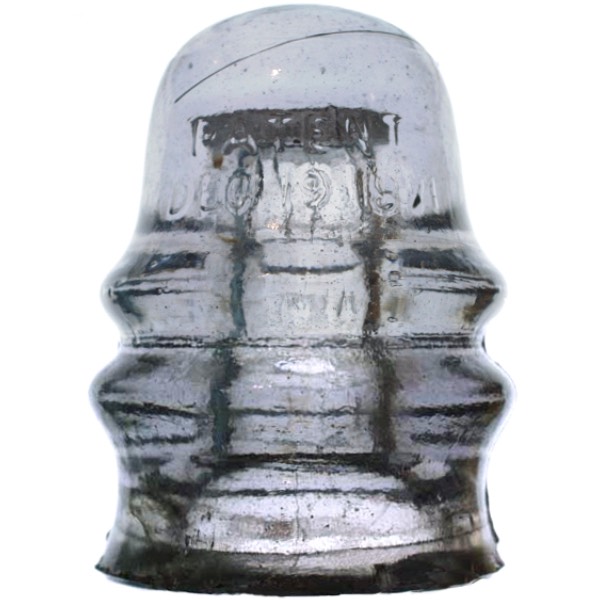CD 732.2
Threadless
Years produced: c.1871
Style (CD) scarcity: 2, Less then 10 known
Intended use: Telegraph
Style / catalog number: Unknown
Number of unique insulators: 7
Notes: Not a lot is known about Hemingray’s production of threadless insulators. They most certainly made some, but to date we only know of one confirmed style. CD 732.2 “Floyd Patent”. Floyd patent refers to the May 14, 1867 (Patent No, 64,654).
It is a patent for a locking insulator pin. Insulator is threadless, the pin “snaps” in to the groove at the top of the insulator.
Only three examples of this Floyd patent insulator are known to exist with the DEC. 19, 1871 date on it, None have the actual Floyd patent date on them. Colors are light sage green and light purple.
There are also unembossed insulators that have the Floyd ring.
Primary Embossing = Embossing on the front of the insulator, usually is that manufacturers name or the customers name. No embossing units will be noted as NO EMBOSSING. Units with no name but with numbers or letters will be noted as NO NAME.
Examples:
HEMINGRAY
S.B.T.&.T.Co
NO NAME
NO EMBOSSING
EIN = Embossing Index Number is a standardized way to identify each unique embossing.
(FS) = Front Skirt
(RS) = Rear Skirt
(DO) = Dome
(CR) = Crown
(FC) = Front Crown
(RC) = Rear Crown
(BG) = Between Grooves
(FA ) = Front, Above wire groove
(FB) = Front, Below wire groove
(BE) = Base Embossed
(FU) = Front Umbrella
(RU) = Rear Umbrella
(FCE) = Front Center
(RCE) = Rear Center
(TE) = Top Ear
(TOP) = Top of Pinhole
/ = Next line of embossing
There are unique characteristics of the insulator that are not related to the embossing, but is worth noting.
Examples:
Factory molded brass bushing
Flaired skirt
MLOB = Mold Line Over Base
Waffle top
Wide saddle groove
Base = the bottom of the insulator. It is noted in the following standardized ways.
SDP = Sharp Drip Points
RDP = Round Drip Points
CB = Corrugated Base
SB = Smooth Base
= Insulator has been verified that exists
= Insulator has been verified that exists, but not listed in the "guide"
= Insulator has not yet been verified as existing
= Suspected error listing in the "guide" because listing does not match up with known manufacturing practices. Such as numbers and dots on an aqua insulator, or insulators listed with both factory molded brass bushing and without. Many do not come in both configurations and are listed as coming in both. Etc.
Color = The approximate color of the insulator. Due to manufacturing variations, insulators with the same color name maybe slightly different in actual appearance.
| Primary Embossing | EIN | Embossing | Special Features | Base | Color | Verified? |
NO EMBOSSING | [010] | (No embossing) | SB | Blue Aqua | ||
NO EMBOSSING | [010] | (No embossing) | SB | Celery Green | ||
NO EMBOSSING | [010] | (No embossing) | SB | Dark Lime Green | ||
NO EMBOSSING | [010] | (No embossing) | SB | Green w/ Milk Swirls | ||
NO EMBOSSING | [010] | (No embossing) | SB | Light Green | ||
PATENT - DEC. 19, 1871 | [010] | (FC) PATENT/DEC. 19. 1871 (RC) 1 | SB | Light Purple | ||
PATENT - DEC. 19, 1871 | [010] | (FC) PATENT/DEC. 19. 1871 (RC) 1 | SB | Light Sage Green |
![CD 732.2 - PATENT - DEC. 19, 1871 - [010] - Light Purple](index_files/small-8578.jpg)
PATENT - DEC. 19, 1871
[010]
Light Purple
Confirmed Hemingray unit. Has the Hemingray Dec. 19, 1871 date (Patent No. 122,015) on it. It also is a threadless version of the CD 131.4
![CD 732.2 - NO EMBOSSING - [010] - Blue Aqua](index_files/small-8579.jpg)
NO EMBOSSING
[010]
Blue Aqua
This example is also made with the Floyd Patent. It has the ring in top of the threadless pinhole. It is the blue aqua color a lot of Hemingray made jars and insulators come in from that time period. Not 100% proof it's a Hemingray but likely is.
![CD 732.2 - NO EMBOSSING - [010] - Green](index_files/small-132912.jpg)
NO EMBOSSING
[010]
Green
This example does not have the Floyd Patent ring. The mold lines and profile is nearly identical to the 1871 marked CD 732.2 and the threaded CD 131.4. Again, not proof it's Hemingray but I suspect it is. Any CD 732.2 is rare so it is a bit hard to “compare” them. This insulator was found in Covington, KY.
Share this page on:
Like or Follow on Facebook:
